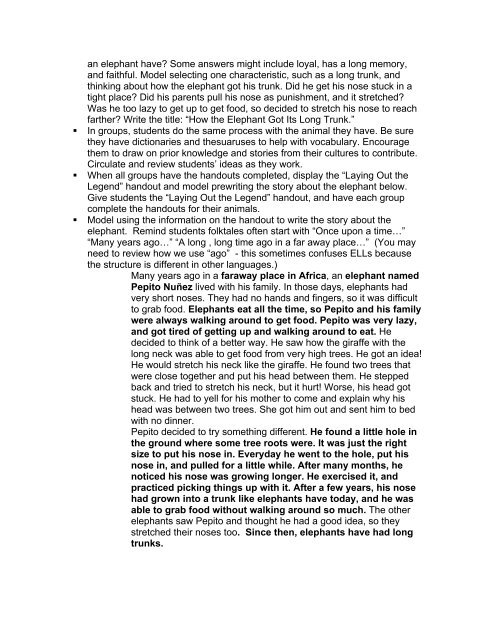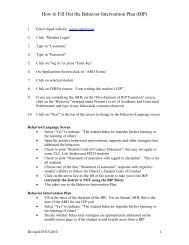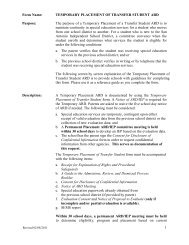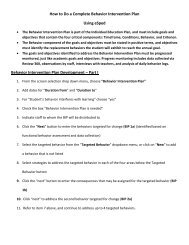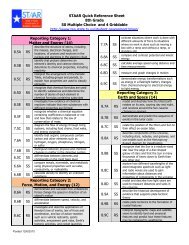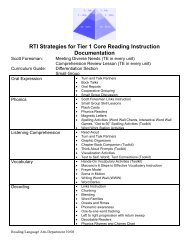Story Writing: Animal Folktales Level of Proficiency: Intermediate ...
Story Writing: Animal Folktales Level of Proficiency: Intermediate ...
Story Writing: Animal Folktales Level of Proficiency: Intermediate ...
You also want an ePaper? Increase the reach of your titles
YUMPU automatically turns print PDFs into web optimized ePapers that Google loves.
an elephant have? Some answers might include loyal, has a long memory,<br />
and faithful. Model selecting one characteristic, such as a long trunk, and<br />
thinking about how the elephant got his trunk. Did he get his nose stuck in a<br />
tight place? Did his parents pull his nose as punishment, and it stretched?<br />
Was he too lazy to get up to get food, so decided to stretch his nose to reach<br />
farther? Write the title: “How the Elephant Got Its Long Trunk.”<br />
In groups, students do the same process with the animal they have. Be sure<br />
they have dictionaries and thesuaruses to help with vocabulary. Encourage<br />
them to draw on prior knowledge and stories from their cultures to contribute.<br />
Circulate and review students’ ideas as they work.<br />
When all groups have the handouts completed, display the “Laying Out the<br />
Legend” handout and model prewriting the story about the elephant below.<br />
Give students the “Laying Out the Legend” handout, and have each group<br />
complete the handouts for their animals.<br />
Model using the information on the handout to write the story about the<br />
elephant. Remind students folktales <strong>of</strong>ten start with “Once upon a time…”<br />
“Many years ago…” “A long , long time ago in a far away place…” (You may<br />
need to review how we use “ago” - this sometimes confuses ELLs because<br />
the structure is different in other languages.)<br />
Many years ago in a faraway place in Africa, an elephant named<br />
Pepito Nuñez lived with his family. In those days, elephants had<br />
very short noses. They had no hands and fingers, so it was difficult<br />
to grab food. Elephants eat all the time, so Pepito and his family<br />
were always walking around to get food. Pepito was very lazy,<br />
and got tired <strong>of</strong> getting up and walking around to eat. He<br />
decided to think <strong>of</strong> a better way. He saw how the giraffe with the<br />
long neck was able to get food from very high trees. He got an idea!<br />
He would stretch his neck like the giraffe. He found two trees that<br />
were close together and put his head between them. He stepped<br />
back and tried to stretch his neck, but it hurt! Worse, his head got<br />
stuck. He had to yell for his mother to come and explain why his<br />
head was between two trees. She got him out and sent him to bed<br />
with no dinner.<br />
Pepito decided to try something different. He found a little hole in<br />
the ground where some tree roots were. It was just the right<br />
size to put his nose in. Everyday he went to the hole, put his<br />
nose in, and pulled for a little while. After many months, he<br />
noticed his nose was growing longer. He exercised it, and<br />
practiced picking things up with it. After a few years, his nose<br />
had grown into a trunk like elephants have today, and he was<br />
able to grab food without walking around so much. The other<br />
elephants saw Pepito and thought he had a good idea, so they<br />
stretched their noses too. Since then, elephants have had long<br />
trunks.


